Julius Caesar’s Conquest of Gaul

Episode 5 Caesar and the Celts
The Celtic World
Dr Jennifer Paxton (2018)
Film Review
Rome’s Long Effort to Subdue the Celts
Prior to Caesar’s conquest of Transalpine Gaul, Rome had a long history of conflict with the Celts, both in France and in the Po Valley of northern Italy. In 218 BC, during the second Punic War, the Carthaginian emperor Hannibal made an alliance with a Celtic tribe called the Boii. Thousands of Celtic warriors joined in Hannibal’s attacks on Rome, resulting in three serious Roman defeats. At Cannae, Hannibal and the Celts killed 50,000 Roman soldiers, nearly annihilating the entire Roman army.
After the Roman’s eventually defeated Hannibal, they drove the Celtic rebels in Italy’s Po Valley across the alps and Romanized those that remained. From then on, the Cisalpine Celts were known as Gallia Togata (Gauls in togas) and the Transalpine Celts the Gallia Comata (hairy Gauls).*
Despite their colonization by Rome, in 73 BC the Cisalpine Celts would defy Rome a second time when they joined in the slave revolt organized by Spartacus (in which most of the latter’s warriors were Celts).
In 181 BC, the Transalpine city-state Massalia (currently Marseilles) requested help from Rome in resisting Celtic pirates. The Roman legions who came to their assistance never left, transforming the Massalia region into the Roman colony called The Province (now known as Provence).
The Celtic Cimbri north of Massala subsequently allied with a Germanic tribe known as the Teutonis to resist Roman occupation. By 105 BC a variety of Celtic coalitions had defeated four Roman armies sent north to contain them.
In 102 BC a Germanic coalition of Teutonis and Ambrones tribes tried to invade the Po Valley and were driven back by the Roman general Gaius Marius.
Julius Caesar’s Conquest of Transalpine Gaul
Caesar’s decision to undertake a series of proxy wars between warring Germanic and Celtic tribes in Transalpine Gaul was mainly political, dictated in large part by his conflicted relationship with Pompeii and Cassius.**
The former’s armies first intervened to support Germanic Soubi warriors who were occupying Celtic Aedui territory. His next move was to attack the Celtic Helvetii,*** who had been forced west when Germanic tribes encroached on their territory.
After massacring 75% of them, Caesar forced the survivors to return to their home region, where both their language and culture were suppressed (and eventually extinguished) by Germanic tribes. He subsequently carried out campaigns against the Aedui, the Sequani, the Belgae, the Veneti and various Germanic tribes on the the east bank of the Rhine. He also made two raids on Celtic Britain in 55 and 54 BC.
The Celtic Revolts
There were two major revolts against Caesar’s occupation of Gaul. In 54 BC, Indutiomarus of the Treveiri tribe led an the first unsuccessful revolt. In 53 BC, Vercingetorix of the Arveni tribe built a multi-tribe alliance and defeated Caesar at Gerogovia. In 52 BC, Caesar ultimately defeated and captured Vercingetorix at the siege of Alesia.
The Romanization of Gaul
Following the Roman conquest and colonization of Transalpine Gaul, the colony was filled with Roman roads, villas and aqueducts, and written and spoken Latin began to replace Celtic dialects. The Celtic language persisted, however, as evidenced by a 2nd century Celtic calendar from Cogny Calendar printed in Roman script.
*The Transalpine Celts were known for long hair and beards, unlike the clean shaven Romans.
**From 60 BC on, the three men ruled Rome as a triumvirate.
***Modern day Switzerland (Confederatio Helvitica) was the former homeland of the Helvetii.
Film can be viewed free with a library card on Kanopy.
https://pukeariki.kanopy.com/en/pukeariki/video/5701024/5701034
The Most Revolutionary Act
- Stuart Jeanne Bramhall's profile
- 11 followers



